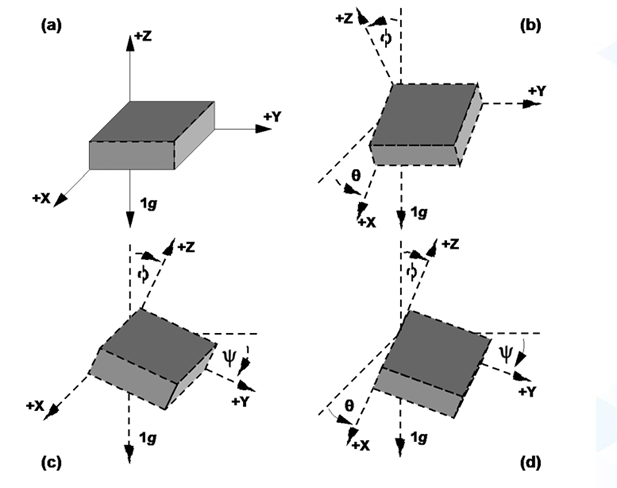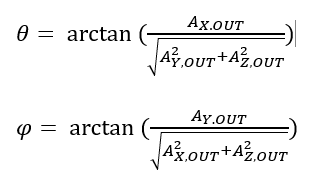Error Analysis and Solutions for High-Precision Inclination Measurement
In the design of high-precision inclination measurement systems, error control is the key to determining system performance. This article combines existing research results and engineering practice to discuss implementation methods, error sources, analysis methods, and solutions from four aspects, providing reference for the design and optimization of high-precision inclination measurement systems.
The principle of measuring tilt angle with an accelerometer is based on the vector decomposition of gravitational acceleration. Under static or quasi-static conditions (without external acceleration interference), when the device tilts, the components of gravity acceleration on the three orthogonal axes (X, Y, Z) of the accelerometer will change. By measuring the proportions of these components, the tilt angle of the device relative to the direction of gravity can be calculated.

As shown in the above figure:

Among them, ![]() reflects the angle between the horizontal plane and the X-axis;
reflects the angle between the horizontal plane and the X-axis;
![]() reflects the angle between the horizontal plane and the Y-axis.
reflects the angle between the horizontal plane and the Y-axis.
⚪ Mechanical vibration: When sensors are installed in a vibrating environment, vibration can cause fluctuations in the output signal, such as in vehicle platforms or industrial equipment scenarios, where vibration may introduce a measurement deviation of ±0.5°.
⚪ Temperature drift: Temperature changes cause sensor zero drift, especially when the operating temperature exceeds the calibration range (such as -20℃~65 ℃), the error can reach 0.002°/℃.
⚪ Electromagnetic interference: Power fluctuations or external electromagnetic fields may interfere with the sensor signal chain, affecting the accuracy of analog-to-digital conversion.
⚪ Nonlinear error: The output of MEMS tilt sensors has a nonlinear relationship with tilt angle, sometimes, non-linear errors can reach a deviation of 0.1° within a range of ± 30 °.
⚪ Noise and resolution limitations: Improper processing of analog signals can lead to a decrease in effective resolution, such as insufficient ADC bits that may not be able to detect small signals at 0.175mV level.
⚪ Installation error: Uneven or loosely fixed base causes the sensor reference plane to be non-parallel to the measured surface, resulting in systematic deviation.
If there is external acceleration (such as vibration or motion) on the device, the output of the accelerometer will contain dynamic acceleration components, resulting in tilt angle calculation errors. At this point, it is necessary to combine gyroscope or magnetometer for data fusion (such as Kalman filtering).
a) Vibration reduction design: Use rubber pads to isolate the vibration source, or select sensors with dynamic filtering function.
b) Temperature compensation:
⚪ Hardware level: Select MEMS chips with built-in temperature sensors to correct drift through real-time temperature acquisition.
⚪ Software level: Establish a temperature error curve fitting equation, such as using polynomial compensation algorithm to reduce the temperature drift accuracy to 0.002 ° @ -20~65 ℃.
c) Power and signal isolation: High stability reference sources (such as LM236) are used to power the sensor, and decoupling circuits are designed to reduce the impact of power ripple.
a) High precision signal chain design:
⚪ Use low-noise operational amplifiers (such as ICL7653) and differential conversion circuits (such as AD8138AR) to improve common mode rejection ratio and signal-to-noise ratio.
⚪ Using a 24-bit ∑-Δ type ADC (such as the built-in ADC in C8051F350), combined with a SINC3 filter to reduce noise and achieve a 20-bit effective resolution.
b) Nonlinear correction: By subdividing the measurement range and fitting it with segmented sine curves, the nonlinear error is reduced from 0.11° to 0.0044°.
a) Dual sensor mapping method: By working together with the first inclination sensor (calibration reference) and the second sensor (to be calibrated) on the installation platform, a linear mapping relationship between the driving angle and the measurement angle is established to correct mechanical installation deviations.
b) Horizontal calibration: Use a high-precision level to calibrate the installation surface, ensuring that the sensor reference plane is parallel to the measured surface, and fix the base with torque screws.
a) Multi sensor fusion: Integrating three-axis accelerometers and gyroscopes, predicting dynamic tilt angles through Kalman filtering or LSTM algorithms, and increasing update rates to over 100Hz.
b) Optimization of the catenary model: Based on the dynamic deformation of the wire, the catenary equation is used to adjust the safety threshold in real-time in combination with environmental parameters (wind speed, temperature), reducing the misjudgment rate to below 0.3%.
The SOC based inclination measurement system (T7000-H series) achieves a maximum absolute error of 0.005° and a relative error of <0.02% through temperature compensation and curve fitting, and has been applied in geological exploration and bridge monitoring.
The T70-B series tilt sensor is designed for the field of explosion-proof hazardous chemical measurement. The internal MCU, MEMS tilt module, power circuit, and output circuit have been optimized through protective design to ensure optimal performance under extreme working conditions and long-term measurement environments. The measurement accuracy can reach 0.01°.
T7000-I wireless tilt sensor is designed for industry applications where users have no power supply or real-time dynamic measurement of object posture and angle. Powered by lithium batteries, based on IoT technology such as Bluetooth and Zigbee (optional) wireless transmission technology, with industrial grade design, it has good long-term stability and small zero drift. It can automatically enter low-power sleep mode, thus eliminating dependence on the usage environment.

1) Intelligent compensation: Utilizing AI algorithms (such as neural networks) to adaptively correct multi-source errors and reduce reliance on manual calibration.
2) Integrated design: Integrating sensors, signal conditioning, and processing units into a single chip to reduce costs and improve reliability.
3) Multi physics field coupling analysis: Combining mechanics, thermodynamics, and electromagnetics models to achieve full condition error prediction.
Through the above technological path, high-precision inclination measurement systems are expected to achieve wider applications in fields such as aerospace, intelligent equipment, and infrastructure monitoring.

Xml política de Privacidade blog Mapa do site
Direitos autorais
@ Micro-Magic Inc. Todos os direitos reservados.
 SUPORTADO POR REDE
SUPORTADO POR REDE
